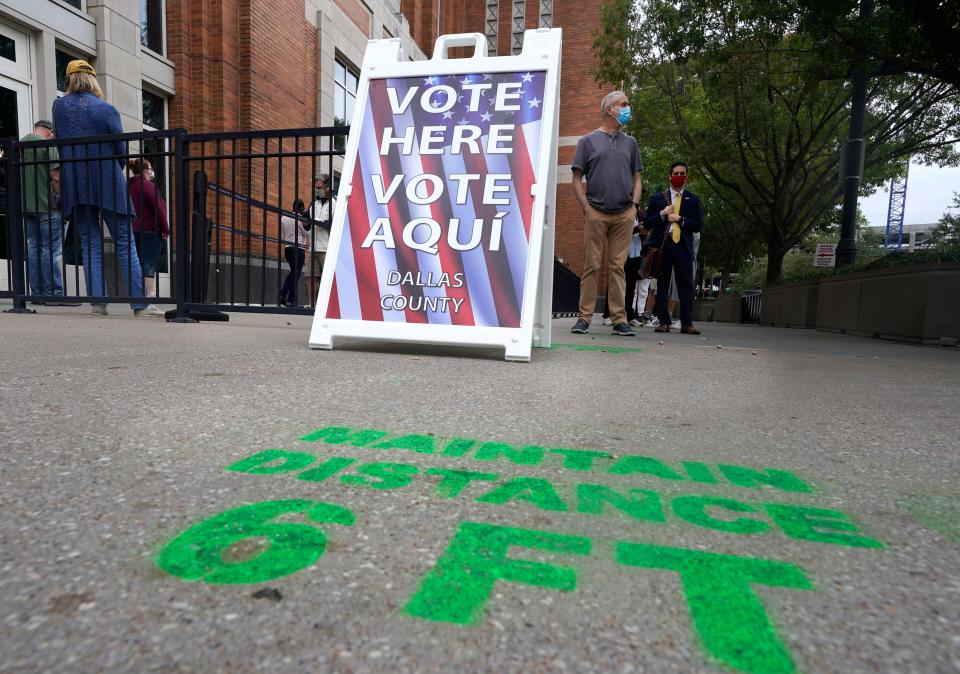America’s political future is a California-Texas duel
If you want to know the potential stakes in Tuesday's national elections, you need not look much further than California and Texas.
These two rival mega-states have developed radically different models of what the nation’s policies could look like if one party becomes dominant in Washington, D.C.
During this year’s presidential campaign, former vice president Joe Biden and President Trump have laid out their parties’ sharply contrasting visions regarding taxes, health care, immigration, energy, the environment, the minimum wage, the response to the pandemic and pretty much any other issue under the sun. But, for at least a generation, neither party has been able to resolve these matters decisively at the federal level. Instead, Washington has been mired in policy vacillation and gridlock, save the few short windows in which one party concurrently held the White House and congressional majorities.
The story has been different in the states.
Over the past generation, many states have become emphatically red or blue, with one party gaining enough dominance to enact a consistent left or right policy agenda. Today, one party controls both houses of the legislature and the governor’s office in more than two-thirds of the states. The nation’s most powerful and populous states, California and Texas, are the prime examples.
Texas and California's policies
During a decade of one-party Democratic rule that began in 2011, California has become the nation’s vanguard of progressive policies. The state has raised taxes, especially on the top 1%; aggressively implemented Obamacare; enacted a statewide $15-per-hour minimum wage; empowered organized labor; declared itself a “sanctuary state;” extended public benefits to undocumented immigrants; and staked out progressive positions on social issues such as abortion rights and LGBT policies. Perhaps most ambitiously, California has established global leadership on climate policy, pursuing the goal of eliminating fossil fuels and achieving carbon neutrality by mid-century.
By contrast, during its era of Republican dominance that began in 2003, Texas has implemented a conservative’s policy dream. It has tenaciously preserved a zero state income tax; kept its overall state tax burden low; lifted regulations on businesses; refused to expand Medicaid; limited the power of organized labor; declined to raise the minimum wage; fought back against Obama-era immigration policies; and promoted conservative positions on contentious social issues.

It’s true that Republicans’ margins in Texas have narrowed, but it’s also safe to say the Lone Star State will continue to pursue conservative policies for the foreseeable future.
The rivalry between the Texas and California policy models is made possible by the nation’s constitutional structure, which, in the words of former Supreme Court justice Louis Brandeis, allows states to serve as “laboratories” and try “novel social and economic experiments without risk to the rest of the country.”
Memo to Trump, Biden and political pundits: Texas is not all about oil and gas anymore
California’s activist, progressive policies and Texas’s market-oriented, conservative alternatives have been in trials for years now, and this year both states’ models are undergoing the extreme stress test of the COVID-19 pandemic (yet another example of how the two states tackled big issues differently, from shutdowns to mask requirements). Voters should be able to compare the costs, benefits, and trade-offs of these competing experiments, and how they might translate to the nation as a whole.
How California and Texas are experiments in opposite policies
For example, voters across the country who wonder how a national “Green New Deal” might work can look to California, which has launched an ambitious program to limit carbon fuels and replace them with alternative energy. The state has gone so far as to ban the sale of new gas-powered cars by 2035. In California, Americans can see how the merits of environmental responsibility must be weighed against regulations that contribute to the state’s extremely high cost of living.
Or, those who wonder what reducing taxes and regulations would do for the nation as a whole can look to Texas, which has doubled down on “business-friendly” policies and has led the fracking revolution that has made the U.S. the global leader in fossil fuel production. Voters can see in Texas a robust record of business growth and overall affordability, but also gaps in environmental protection and essential services for those most in need.
California problems: In California, people lived on the edge of homelessness before COVID-19. Now, it's worse.
Of course, as Americans consider their voting options, many are focusing on more than policy alone. Especially when casting their vote for president, people will reasonably consider other factors, including the personal qualities of Biden and Trump.
But in our polarized age, the radically different state-level experiments in California and Texas give us glimpses of the future that our nation may or may not want. The outcome of next week’s national elections could have massive policy consequences for the country as a whole — especially if one party wins decisively.
Or maybe voters, no matter what happens Tuesday, will gravitate toward a future that isn’t Texas red or California blue — but rather a shade that’s somewhere in between.
But given the partisanship of the day, perhaps that’s just California dreamin’.
Kenneth P. Miller is associate director of the Rose Institute of State and Local Government at Claremont McKenna College and author of "Texas vs. California: A History of Their Struggle for the Future of America."
You can read diverse opinions from our Board of Contributors and other writers on the Opinion front page, on Twitter @usatodayopinion and in our daily Opinion newsletter. To respond to a column, submit a comment to letters@usatoday.com.
This article originally appeared on USA TODAY: How California and Texas are the U.S.'s great rivals in policy

